Interlining is an accessory of garments. It’s sewn or attached to the garment for functional uses. In this context, we will discuss interlining.
Table of Contents
What is Interlining?
Interlining is an extra layer of fabric between the outer layers of garments. It can make the clothes or items keep their shape better. It can help prevent wrinkles, so the clothes look nice for longer. This is useful for things like suits and coats.
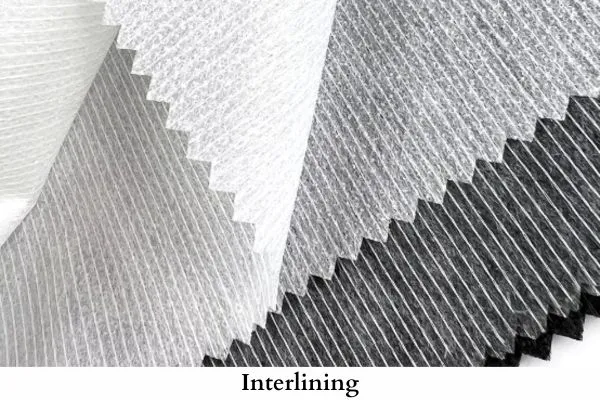
Types of Interlining
1. Fusible Interlining:
Fusible interlining utilizes heat-activated adhesive to bond the interlining material to the fabric. This method is widely used in mass production. Fusible interlining is known for its efficiency and ease of application.
Material Composition
In the garments industry, fusible interlining is mainly used. The fusible interlining is composed of the following three types of materials.
- Base fabric
- Base fabric finishing
- Resin coating
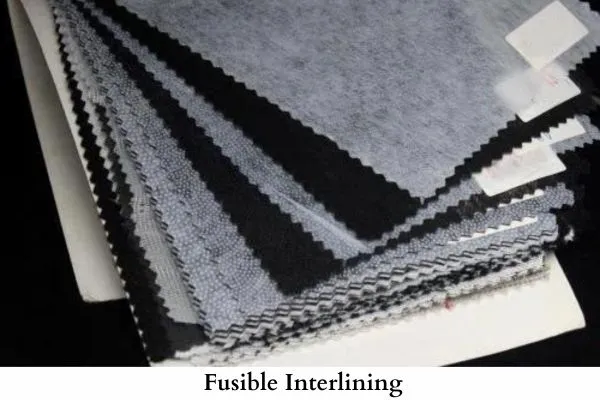
1. Base fabric: Fusible interlining made from cotton base fabric is always preferred. If both apparel and interlining are made from cotton, the dye pick-up will be equal during apparel dyeing.
In the case of using non-woven cotton fabric, these properties must be present.
i) If any resin is used as the binder, it should not create any problem with dye penetration.
ii) Due to apparel dyeing, the properties of non-woven base fabric should be unaffected.
Base fabric finishing: Dimethyl urea derivative base resin is normally used for cotton base fabric finishing, creating problems during apparel dyeing.
If the base fabric is mechanically shrunken and low formaldehyde resin is used for base fabric finishing, then the problem of dye penetration will be reduced. (The best outcome is possible if only mechanical shrinking is applied without using low formaldehyde)
2. Fusible Resin Coating: Due to dyeing temperature, chemicals used in the dye baths, and longer periods of agitation onto the garments, spitting of the interlining fabric and garment fabric may occur by breaking bonding between those two fabrics.
3. Resin Coating: The resin used for coating should be hydrophobic, and melting-type resin works well in apparel dyeing.
If scattered-coated interlining is used, a blister may form during apparel dyeing. Hence dot, coated interlining is better to use in the garments to be dyed.
Materials of Fusing Interlining:
- Polyester or Nylon Fabric with Adhesive Coating:
- Fusing interlining is commonly made from polyester or nylon fabric treated with a heat-activated adhesive coating. This adhesive allows the interlining to bond with the main fabric, creating a strong and durable connection when subjected to heat.
- Polyester Mesh:
- In some cases, a lightweight polyester mesh is used for fusing interlining. The open mesh structure facilitates breathability while still providing the necessary reinforcement.
- Polyamide (Nylon) Films:
- Thin polyamide films with adhesive properties are utilized in fusing interlining, adding minimal weight to the fabric while ensuring a secure bond. These films are often transparent and discreet, preserving the original appearance of the fabric.
- Polyurethane Foam:
- Polyurethane foam may be used as fusing interlining for applications requiring added thickness and softness. This material provides a cushioning effect while maintaining the ease of fusing with heat.
Advantages of fusing in garments
- Cheap, low labor cost, high production.
- Quick and efficient application.
- Maintains the original texture of the fabric.
- Ideal for mass production.
Disadvantages:
- Limited flexibility compared to sewn interlining.
- May lose adhesion over time with repeated washings.
2. Non-Fusible or Sewn Interlining
As the name suggests, sewn interlining involves physically sewing an additional layer of fabric or material to the main fabric. This nonfusible traditional method is often employed in tailoring and allows for a more flexible and natural feel in the finished garment.
Materials of Non-fusing Interlining:
- Cotton: Cotton is a common choice for non-fusing interlining, especially in garments where breathability and a natural feel are essential. It is often used in tailored clothing to provide structure without compromising comfort.
- Wool: Wool interlining is favored for adding warmth and structure to garments. It is commonly used in suits and coats, where the goal is to enhance the fabric’s drape while maintaining a luxurious feel.
- Horsehair Canvas: Traditional tailoring often involves using horsehair canvas as a non-fusing interlining. This material is prized for its durability and ability to shape itself to the body over time, creating a personalized fit.
- Polyester: Polyester interlining is known for its affordability and versatility. It is frequently used in non-fusing applications where synthetic material is preferred for its resistance to wrinkles and ease of maintenance.
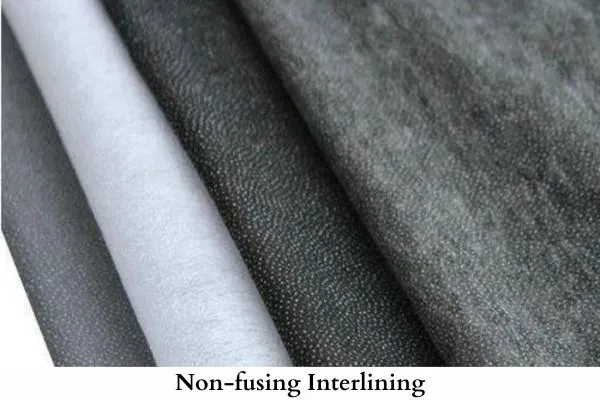
Advantages:
- Enhanced flexibility and drape.
- Long-lasting durability.
- It can be easily replaced or altered.
Disadvantages:
- Labor-intensive process.
- It may alter the natural texture of the fabric.
Difference between Fusing and Non-fusing Interlining
| Feature | Fusing Interlining | Non-fusing Interlining |
|---|---|---|
| Application Process | Requires heat activation (ironing or pressing). | Applied through sewing or stitching. |
| Speed of Application | Quick and efficient, ideal for mass production. | Labor-intensive, slower compared to fusing. |
| Flexibility | Offers limited flexibility compared to sewing. | It may alter the natural texture of the fabric. |
| Texture Alteration | Maintains the original texture of the fabric. | It is challenging to replace or alter once applied. |
| Durability | Adhesion may weaken with repeated washings. | Known for long-lasting durability. |
| Replacement/Alteration | It can be easily replaced or altered if necessary. | Relatively simple. |
| Common Use Cases | Mass production and ready-made garments. | Tailoring and bespoke clothing. |
| Complexity of Process | It may be more expensive due to labor-intensive process. | Requires skilled craftsmanship in the sewing process. |
| Cost | Often cost-effective for large-scale production. | It may be more expensive due to the labor-intensive process. |
Application
- Tailored Suits and Formal Attire:
- Non-fusing Interlining: Used for bespoke suits where a natural drape and tailored fit are crucial. Common materials include cotton and horsehair canvas.
- Fusing Interlining: Ideal for mass production of formal wear, ensuring a consistent and efficient application of interlining with materials like polyester or nylon fabric.
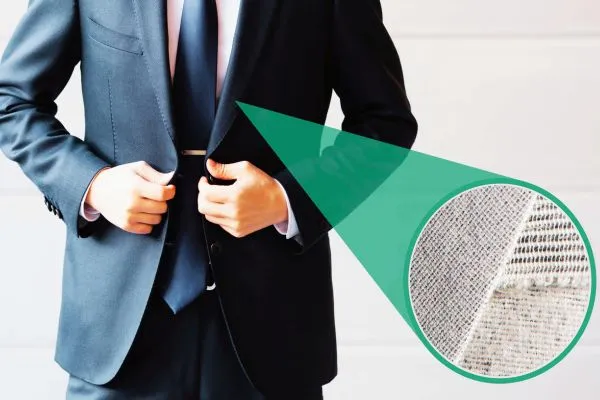
- School Uniforms and Workwear:
- Fusing Interlining: Perfect for the quick and uniform application required in the mass production of school uniforms or workwear. Heat-activated adhesives ensure efficiency and a neat appearance.
- Non-fusing Interlining: Offers a more personalized touch in work uniforms, where a tailored fit may be preferred for comfort and style.
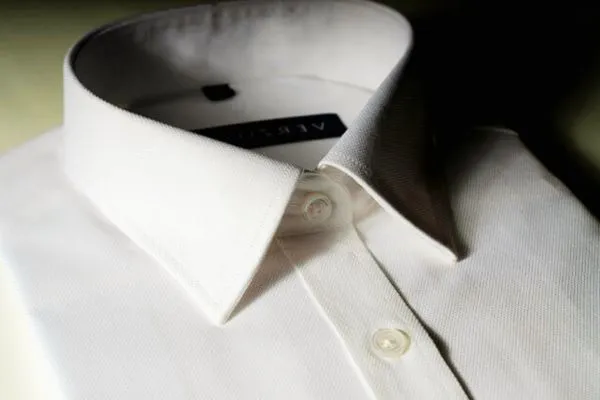
- Casual Jackets and Outerwear:
- Non-fusing Interlining: Provides comfort and flexibility in casual jackets, maintaining a relaxed fit. Wool interlining is commonly used for added warmth.
- Fusing Interlining: This enables a streamlined process for lightweight outerwear, ensuring a practical and contemporary look.
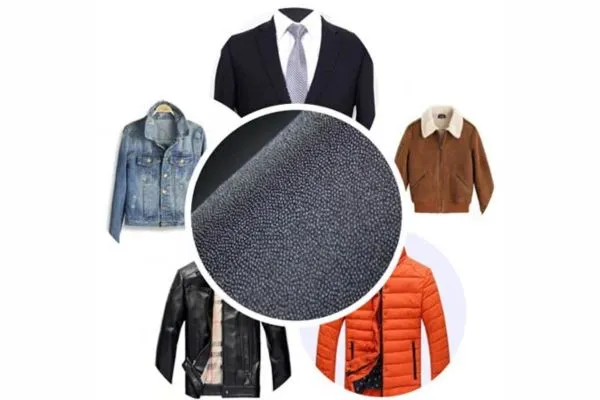
- Formal Shirt Collars:
- Fusing Interlining: Ensures precision in shirt collars, allowing for a crisp and defined appearance. Polyester mesh or adhesive-coated fabrics contribute to a polished look.
- Non-fusing Interlining: This is less common in shirt collars, but it might involve traditional tailoring techniques for a unique touch when used.
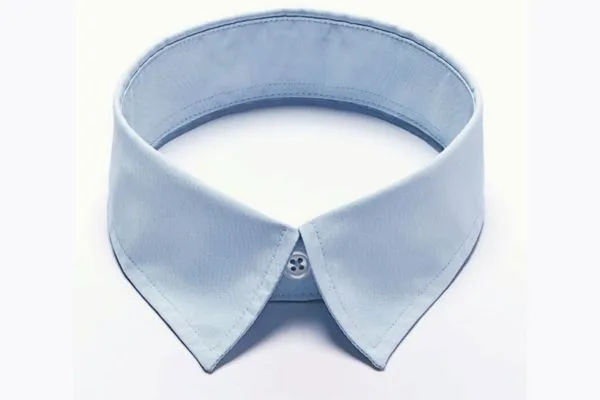
- Classic Overcoats and Winter Apparel:
- Non-fusing Interlining: Adds warmth to classic overcoats without sacrificing style. Wool interlining is a popular choice for its insulation properties.
- Fusing Interlining: Rare in winter apparel but could be a lightweight option with heat-activated adhesives.
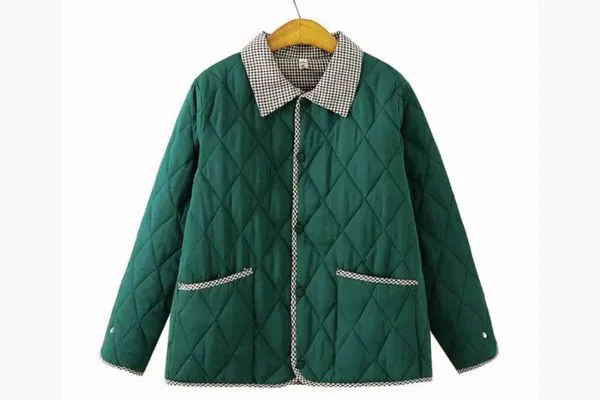
Everyday Dresses and Casual Wear:
Fusing Interlining: Provides ease in the production of everyday dresses, where a lightweight and comfortable feel is desired. Polyester mesh or adhesive-coated materials offer efficiency.
Non-fusing Interlining: Less common in casual wear but could be used for specific design preferences, employing materials like cotton for added structure.

- Corporate Uniforms and Professional Attire:
- Fusing Interlining: Ensures uniformity in corporate attire through quick and consistent application, contributing to a polished and professional look. Materials like polyester or nylon are commonly used.
- Non-fusing Interlining: Uncommon due to the labor-intensive process, but could be employed for unique, high-end corporate uniforms where a tailored fit is prioritized.

Conclusion
Interlining is a critical accessory in the realm of textiles, a behind-the-scenes hero that plays a pivotal role in enhancing the structure, appearance, and performance of fabrics. Essentially, interlining is a layer of material inserted between the main fabric layers to provide additional support, shape, and durability. It’s like the unsung hero of the fashion and textile world, silently contributing to the quality and functionality of various garments.
